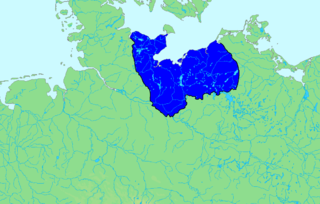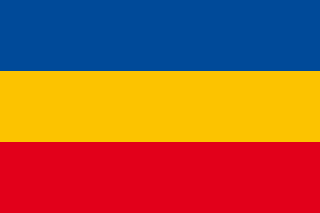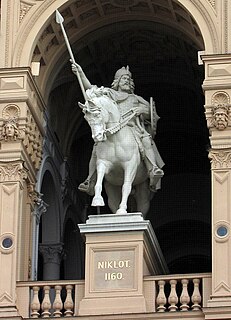Nako, Nakon, Nakko, or Nacco (flourished 954 – ca. 966) was an Obotrite leader who, along with his brother Stoigniew, led the forces of a Slavic confederacy in a revolt against the Germans, especially Herman Billung, Duke of Saxony. [1]
Stoigniew was an Obotrite leader, reigning in the middle of the tenth century. He is mentioned as a member of the princely Nakonid dynasty in the medieval chronicles of Thietmar of Merseburg and Widukind of Corvey.

Polabian Slavs is a collective term applied to a number of Lechitic tribes who lived along the Elbe river in what is today Eastern Germany. The approximate territory stretched from the Baltic Sea in the north, the Saale and the Limes Saxoniae in the west, the Ore Mountains and the Western Sudetes in the south, and Poland in the east. They have also been known as Elbe Slavs or Wends. Their name derives from the Slavic po, meaning "by/next to/along", and the Slavic name for the Elbe.
A confederation is a union of sovereign states, united for purposes of common action often in relation to other states. Usually created by a treaty, confederations of states tend to be established for dealing with critical issues, such as defense, foreign relations, internal trade or currency, with the general government being required to provide support for all its members. Confederalism represents a main form of inter-governmentalism, this being defined as any form of interaction between states which takes place on the basis of sovereign independence or government.
In 955 Nako and Stoignew were defeated at the Battle of Recknitz by Otto I of Germany. While Stoignew was beheaded, Nako probably accepted Christianity, because there followed roughly thirty years of peace, during which, according to Adam of Bremen, the Slavs were Christian. Nako and his successors, the Nakonids, resided in a "ringwall" of fortresses: Mecklenburg, Starigard, Liubice, and Lenzen (Lunkini). When the Sephardic geographer Abraham ben Jacob travelled through the territory, he referred to Mecklenburg, Nako's principal palace, as "Nako's castle."
Christianity is an Abrahamic religion based on the life and teachings of Jesus of Nazareth, as described in the New Testament. Its adherents, known as Christians, believe that Jesus Christ is the Son of God and savior of all people, whose coming as the Messiah was prophesied in the Old Testament.

Adam of Bremen was a German medieval chronicler. He lived and worked in the second half of the eleventh century. Adamus is most famous for his chronicle Gesta Hammaburgensis Ecclesiae Pontificum.
The Nakonids were the leading noble family of the Slavic peoples of the Elbe River from ca. 960 until 1129. They were themselves of Obotrite origin and engineered the formation of a Slavic principality in the region. They became extinct in the male line in the early 12th century. Their capital was Mecklenburg Castle.
He was succeeded by his sons Mstivoj and Mstidrag, but they abandoned Christianity and revolted against the Germans again.
Mstivoj was an Obodrite prince from 965 or 967 until his death. He inherited his position along with his brother Mstidrag from their father Nako in an unknown year.










